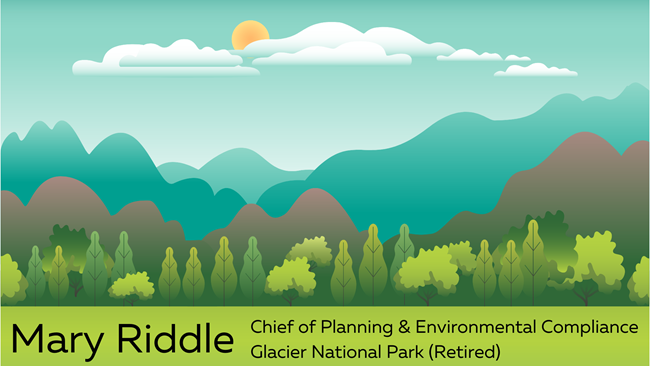Last updated: March 24, 2022
Article
Women in Landscape-Scale Conservation: Mary Riddle

How did you get started working in landscape-scale conservation?
I came to Glacier National Park in 1995 to lead the development of the General Management Plan(GMP). Glacier is the world's first International Peace Park with Waterton Lakes National Park in Canada (just to the north). The Superintendent wanted to include input from Waterton Lakes NP and for them to participate in development of the GMP. I got to know the Waterton staff very well through that process. In 2001, Glacier and Waterton, and representatives from the Government of Alberta and Government of BC, formed an informal lands manager group called the Crown Managers Partnership (CMP). I was asked to help facilitate the first CMP meeting in Cranbrook, BC. About 2004 (I am fuzzy on the exact year) I became Glacier's official representative on the steering committee; about 2010 I became the Co-Chair until I retired in 2021.What does the term connected conservation mean to you?
Connected conservation means working across jurisdictional boundaries on common issues and challenges to effect resilience, response, and change at a landscape scale.
Tell us about a project that you have worked on that you are especially proud of.
The Crown Managers Partnership was able to accomplish quite a few projects since it began. I am most proud of actually two of those projects. One was the development of a transboundary GIS database that covered the 18 million acre Crown. Because Federal, State, Provincial, Tribes and First Nations all worked with different programs and software, it took a major effort to develop a single database that knit all the layers together. We worked first with the Miistakkis Institute in Canada and then with the Geography Dept. at the University of Calgary. The University of Montana was also integral in this effort. This effort also required all Provincial, State, Federal, Tribal and First Nations land managers to share their data.If you could collaborate with anyone or any organization who would it be?
I would like to urge more parks to connect with their neighboring land managers and private land managers. Parks no longer have the ability to stand on their boundaries looking inward. We have to stand looking outward to and with our neighbors because it is only through developing collaborative relationships will we be able to protect the nation's park resources and address issues such as climate change, wildlife connectivity corridors, invasive species, water quality, fire, and many others.
